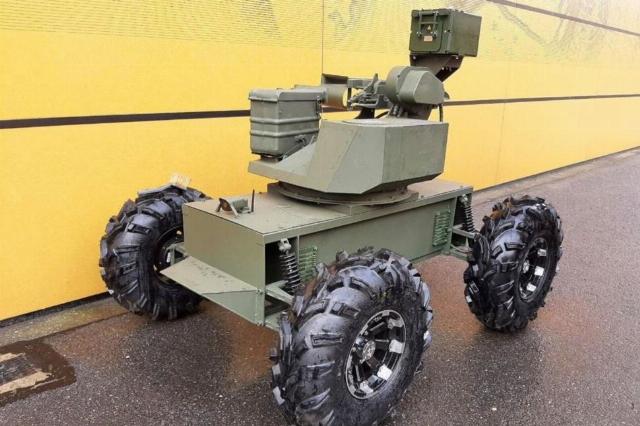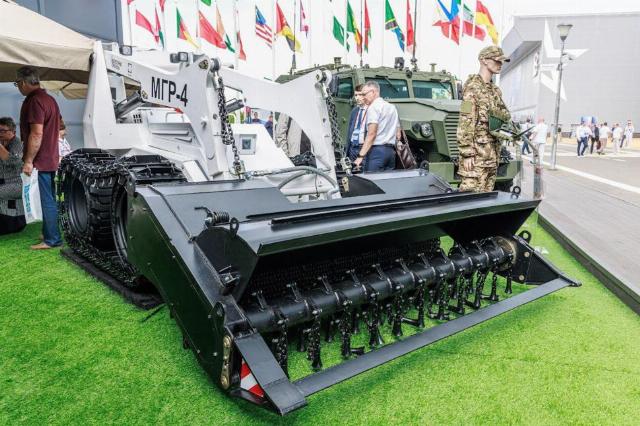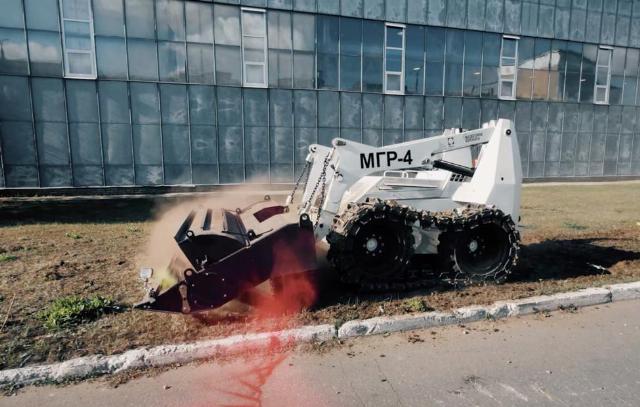Robotic novelties
One of the novelties is a multifunctional robotic complex with a tracked NPA "Dispatch", which Rostec State Corporation called the world's first FPV complex. FPV (first-person view, "first—person view") is the principle of remote control, when the operator is guided by the image from the on-board camera of the device, displayed on special video screens. This creates the illusion of the presence of controlled equipment on board, which facilitates control. The Dispatch complex, developed by specialists of the Instrument Engineering Design Bureau (KBP) of the High—Precision Complexes holding (part of Rostec), is capable of hitting manpower and various enemy fortifications, mining, delivering cargoes - ammunition, fuel, provisions to fighters. The 150 kg payload capacity of the tracked vehicle even allows it to evacuate the wounded from the front edge. Currently, the Dispatch is being comprehensively tested, including in a special military operation.

Prototype of the Buggy drone
Image source: © Rostec State Corporation
Another universal HPA "Buggy" was developed by the Signal Research Institute (also included in the "High-precision Complexes") and is capable of carrying up to 250 kg of payload. It is built on a wheeled platform, controlled by a joystick and a tablet. Both the Buggy and the Dispatch can act as kamikaze drones, delivering an explosive charge to the target.
The work of the robot with a load capacity of 250 kg was shown by the Ministry of Defense of the Russian Federation. In the released footage, a remotely controlled wheeled vehicle carries various loads in a spacious body, crossing a forest road and a field. The device with an electric drive can accelerate up to 40 km/h, its power reserve is 40 km.
The armed forces of the Russian Federation have begun to use a new ground-based kamikaze drone "Frog". As follows from the message of the Russian Ministry of Defense, the device is a small, simple four-wheeled platform with a built-in video camera. The range of application of the "Frog" exceeds 3 km. The footage distributed by the military department shows the first combat use of a wheeled vehicle: having overcome 700 m, it destroyed the enemy's machine-gun crew. One of the advantages of the "Frog" was called a large payload capacity compared to kamikaze quadrocopters: 30 kg against 3-4 kg of the typical payload of its flying counterparts.
Two million for a captured Estonian robot
Various NPA are also used by the Armed Forces of Ukraine. In 2022, the Estonian company Milrem Robotics, a controlling stake in which belongs to the defense conglomerate EDGE Group from the United Arab Emirates, began supplying Ukraine with tracked land-based uninhabited THeMIS vehicles for mine clearance, cargo delivery and medical evacuation. According to the company, Kiev should receive a total of 14 devices, which are paid for by the German Ministry of Defense. In September 2022, the Russian Center for Analysis of Strategies and Technologies (CAST) announced its readiness to pay 1 million rubles for a serviceable THeMIS captured during its operation. Later, the amount was increased to 2 million. In March of this year, footage appeared on Russian Telegram channels allegedly showing the destruction of an Estonian tracked platform, and in mid-May of this year, reports of the seizure of such a device and its photos. "The center is ready to pay 2 million to the fighters who seized this platform," Ruslan Pukhov, the head of the CAST, told TASS. "In the near future, we will start consultations with the Ministry of Defense in order to establish all the circumstances for certain." According to the head of the organization, it is necessary to make sure that THeMIS has not received serious damage and is suitable for study.
The Impulse-M multi-purpose tracked platform with a rocket module is undergoing field tests. It was developed by Gumich company together with Rostec. Alexander Gavrilov, CEO of the developer company, in an interview with TASS, said that the load capacity of the platform is 1 ton, while it is capable of transporting 1.5 tons of cargo on a trailer. The development is universal and, with the help of interchangeable modules, can both attack the enemy, set mines, and transport the wounded. A feature of the system is a fully Russian control module with artificial intelligence, which allows the device to act independently in many scenarios. For example, in case of a violation of the communication channel with the operator, Impulse-M is able to return to the starting point at points on the ground recorded in the on-board computer.
Universal robot "Impulse-M"
Image source: © "Gumich"
The combat module with which the Impulse-M is being tested is equipped with an anti-tank missile system. A scaled-down prototype of the combat robot was successfully tested during a special military operation.
Robots equipped with Triton electronic warfare (EW) stations developed by the PPSH Laboratory company began to cover groups engaged in the evacuation of wounded soldiers. Denis Oslomenko, Head of the Laboratory PPSh", explained that there are gray zones in the places of hostilities, where it is dangerous to send evacuation teams due to enemy attempts to destroy them with the help of attack drones. The way out is robotic platforms that interfere with UAVs. Also in the company's concept there is a robot designed for electronic warfare-covering assault groups of military personnel or shock troops.
Existing ones are being improved
Already created NPA are constantly being improved. For example, the remotely operated MGR-4 Bumblebee, designed for mine clearance, encountered the operation of enemy electronic countermeasures systems during tests in Mariupol.

The MGR-4 Bumblebee remotely operated vehicle
Image source: © Telegram-channel of Rostec State Corporation
"We took into account all these factors, and already in February the tests at the same test site passed without communication failures," Alexander Dernovoy, Deputy General Director of High—Precision Complexes for the promotion of civilian products, told TASS. — An additional (backup) communication channel has been introduced as a means to ensure communication between the machine and the control panel in a complex radio frequency broadcast environment. New variants of hydraulic locomotion motors and a hammer shaft drive pump have also been applied. This made it possible to increase the cross-country ability of the machine, especially in places with viscous soil."
"The topic is very in demand and very relevant"
The Ministry of Defense of the Russian Federation pays great attention to the development of land-based uninhabited vehicles. In April of this year, Sergei Shoigu, who served as the Minister of Defense of the Russian Federation, checked the implementation of instructions at the Patriot Convention and Exhibition Center, according to which promising robotic complexes are being developed. Shoigu was shown numerous wheeled and tracked vehicles for installing weapons, supplying units and medical evacuation.
"This topic is very in demand and very relevant," Alexey Sakantsev, an officer of the reserve of missile forces and artillery, a combat veteran involved in the development of the NPA, expressed his opinion in an interview with TASS. — In fact, what is happening now <...> is a kind of breakthrough into the real war of the XXI century. In the First World War, tanks appeared that were able to <...> overcome defensive lines, trenches, and barbed wire. Nowadays, when a tank can no longer cope with this, <...> we are moving towards the use of combat robots."
The expert believes that robotic complexes have much more advantages than disadvantages. "If it is a [remotely] piloted vehicle, it has only one drawback — it is a communication channel. We need to communicate with him somehow, we need to send him commands. And the communication channel can always be lost," the specialist said, adding that in the case of a radio channel, it can be jammed by the enemy, its operation will be disrupted by the folds of the terrain or the antenna will be damaged. "Everything else is a solid plus," Sakantsev shared his opinion.
Alexey Sakantsev
reserve officer of the missile forces and artillery, combat veteran
The specialist noted that ground-based robotic complexes are divided into remotely controlled and capable of operating autonomously. The latter, in his opinion, are the most promising. At the same time, it is more expedient to use reusable NPA, where only ammunition will be "expendable". "Naturally, you can always lose it, the enemy can destroy it, but if he completes the task at least a few times, it's already good," Sakantsev believes. In his opinion, a reusable attack robot should not be unnecessarily expensive, since there is a risk of its defeat by cheap FPV drones.
Alexey Sakantsev expressed the opinion that several types of NPA will be in demand on the modern battlefield. First of all, these are the so-called automatic leading edge conveyors, which have already been created, mass-produced and used, and designers are experimenting with various chassis options. The operation of such a device is cheaper than the Ural army vehicle. "Many transporters do not initiate anti—tank mines with their mass — they are too light and the load on the ground is too small," the expert said, adding that such a vehicle, due to the quietness of the electric version, allows you to break through to the front line, bringing goods and taking away the wounded. Another class of promising vehicles is autonomous mine clearance vehicles.
"The [NNA] theme allows saving human lives and health through the production of apparatuses, soulless machines. This is very important," Sakantsev shared his opinion.
Victor Bodrov

